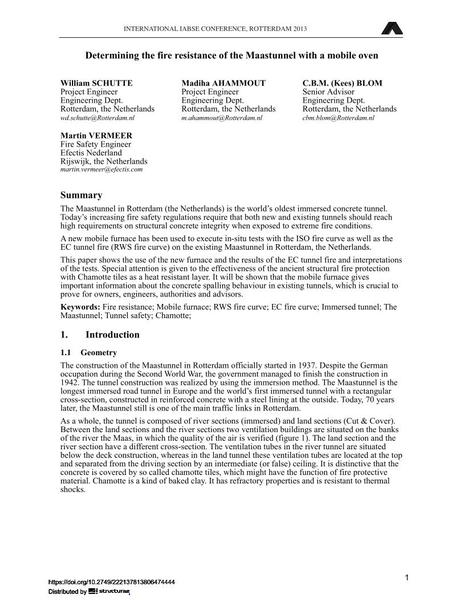Determining the fire resistance of the Maastunnel with a mobile oven

|
|
|||||||||||
Bibliografische Angaben
| Autor(en): |
William schutte
Madiha Ahammout C. B. M. (Kees) Blom Martin Vermeer |
||||
|---|---|---|---|---|---|
| Medium: | Tagungsbeitrag | ||||
| Sprache(n): | Englisch | ||||
| Tagung: | IABSE Conference: Assessment, Upgrading and Refurbishment of Infrastructures, Rotterdam, The Netherlands, 6-8 May 2013 | ||||
| Veröffentlicht in: | IABSE Conference, Rotterdam, May 2013 | ||||
|
|||||
| Seite(n): | 114-115 | ||||
| Anzahl der Seiten (im PDF): | 8 | ||||
| Jahr: | 2013 | ||||
| DOI: | 10.2749/222137813806474444 | ||||
| Abstrakt: |
The Maastunnel in Rotterdam (the Netherlands) is the world’s oldest immersed concrete tunnel. Today’s increasing fire safety regulations require that both new and existing tunnels should reach high requirements on structural concrete integrity when exposed to extreme fire conditions. A new mobile furnace has been used to execute in-situ tests with the ISO fire curve as well as the EC tunnel fire (RWS fire curve) on the existing Maastunnel in Rotterdam, the Netherlands. This paper shows the use of the new furnace and the results of the EC tunnel fire and interpretations of the tests. Special attention is given to the effectiveness of the ancient structural fire protection with Chamotte tiles as a heat resistant layer. It will be shown that the mobile furnace gives important information about the concrete spalling behaviour in existing tunnels, which is crucial to prove for owners, engineers, authorities and advisors. |
||||
| Stichwörter: |
Absenktunnel Feuerwiderstand Tunnelsicherheit
|
||||
